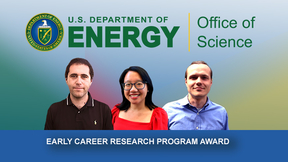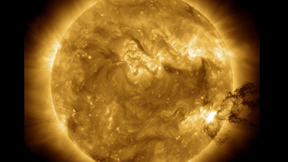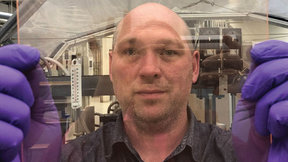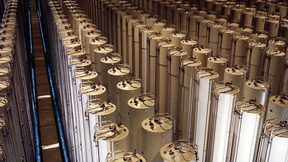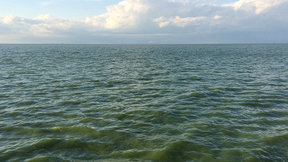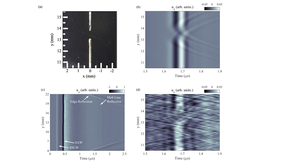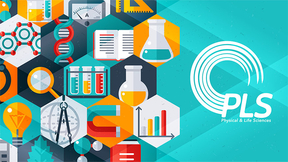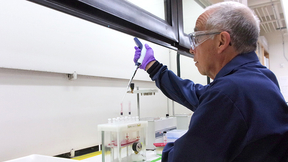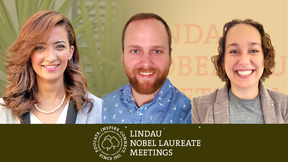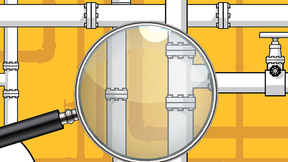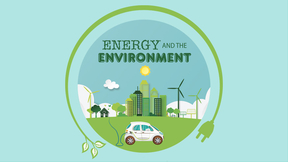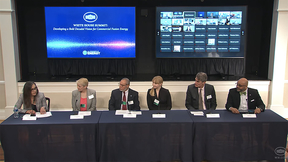Back
Physical and Life Sciences
DOE honors three early-career Lab scientists
Three scientists from Lawrence Livermore National Laboratory (LLNL) are recipients of the Department of Energy’s (DOE) Office of Science Early Career Research Program award. Mimi Yung, John Despotopulos and Timofey Frolov are among 83 awardees receiving the recognition. Under the program, typical awards for DOE national laboratory staff are $500,000 per year for five years…
Short Wavelengths Yield Big Dividends
Collaborative research and development focused on the extreme ultraviolet (EUV) end of the spectrum has resulted in state-of-the-art, multilayer reflective optics used for space exploration, manufacturing microchips, and more.
Additive Manufacturing Brings New Possibilities for Transparent Ceramics
Having developed several transparent ceramics for radiation detection applications for the Department of Homeland Security and the Stockpile Stewardship Program, Lawrence Livermore recently leveraged its unique additive manufacturing resources and capabilities to develop transparent ceramics with properties not previously available for use as laser materials.
The ACES in Our Hand
The Adaptive Computing Environment and Simulations (ACES) project will advance fissile materials production models and reduce risk of nuclear proliferation.
Going beyond Mother Nature’s molecules to target radioactive metals
Lawrence Livermore National Laboratory (LLNL) scientists and collaborators at Penn State University are improving natural molecules that would help target specific radioactive elements that are found in nuclear waste or used in nuclear medicine. Even the most effective molecules found in nature, which underwent billions of years of evolution, can still be improved for non…
With better algal forecasts comes safer water
Lawrence Livermore National Laboratory (LLNL) scientists and collaborators have used a new technique to better forecast the level of algal toxins that accumulate in Lake Erie every year. Harmful algal blooms (HABs) are global phenomena and, in freshwater lakes and reservoirs, are caused by cyanobacteria of the genus Microcystis that produce microcystins, a suite of amino…
Laser-based ultrasound detects defect-producing features in metal 3D printing
Lawrence Livermore National Laboratory (LLNL) researchers have developed a new all-optical ultrasound technique capable of performing on-demand characterization of melt tracks and detecting formation of defects in a popular metal 3D printing process. In a paper published by Scientific Reports, Lab researchers propose a diagnostic using surface acoustic waves (SAW),…
LLNL partners with city of Livermore to reduce carbon emissions
Lawrence Livermore National Laboratory (LLNL) has signed a memorandum of understanding (MOU) with the city of Livermore to collaborate on advancing climate action in Livermore and build community-wide resilience to climate change impacts. The city’s Climate Action Plan (CAP), anticipated to be adopted by the Livermore City Council this summer, will create a roadmap to…
Scientists study superheavy elements for extraction methods
Advancing superheavy-element chemistry—the study of elements with an atomic number greater than 103—is a challenging task because of their scarce production rates and relatively short half-lives (i.e., less than 1 minute for most), thus requiring studies to be performed at the atom-at-a-time scale. The properties of these elements are linked to the physics and chemistry at…
Space weather satellite includes LLNL-developed optics
The National Oceanic and Atmospheric Administration (NOAA) and National Aeronautics and Space Administration (NASA) successfully launched the GOES-T space weather satellite on March 1, 2022. The satellite’s solar ultraviolet imager (SUVI)—an instrument used to record full-disk images at 6 extreme ultraviolet (EUV) wavelengths every few minutes and from a single telescope…
The Simple Cloud-Resolving E3SM Atmosphere Model (SCREAM)
Numerical models are a critical tool for predicting Earth’s future climate conditions due to the complex and inter-related processes controlling weather. While simulating the whole planet imposes severe computational challenges, global coverage is nonetheless necessary as local behavior propagates rapidly to distant areas of the globe. To solve these challenges, Peter…
Speeding up detection of climate change response to emission reductions
If humans decrease their greenhouse gas emissions to the atmosphere, how quickly would we detect a slowdown in global warming? In a recent study published in Nature Communications, Lawrence Livermore National Laboratory (LLNL) climate scientist Mark Zelinka and collaborators developed a novel approach to more quickly see the temperature response to strong emissions…
LLNL garners 'A' grade in OPCW environmental test
Even after taking highly stressful exams in college, grades can still be important. Just ask researchers at Lawrence Livermore National Laboratory’s (LLNL) Forensic Science Center (FSC). Every fall, chemists and other researchers from the FSC spend two weeks of long days undertaking the Organisation for the Prohibition of Chemical Weapons (OPCW) environmental proficiency…
Americans move to more solar and wind power in 2021
The national economy is reenergizing, quite literally. In 2021, Americans used 5% more energy than in 2020, according to the most recent energy flow charts released by Lawrence Livermore National Laboratory (LLNL). Each year, LLNL releases flow charts that illustrate the nation's consumption and use of energy. In 2021, Americans used 97.3 quads (quadrillion BTU) of energy,…
Three Lab postdocs selected to attend the 71st annual Lindau Nobel Laureate meeting
Three Lawrence Livermore National Laboratory (LLNL) postdoctoral appointees have been selected to attend the 71st annual Lindau Nobel Laureate meeting in Germany this summer thanks to the University of California President’s 2022 Lindau Nobel Laureate Meetings Fellows Program. The three selected to attend are Magi Mettry, Johanna Schwartz and Dane Sterbentz. The Lindau…
A Watery Detective Story
As with most mysteries, this one starts with a puzzling scene: a waterlogged field situated near Lawrence Livermore and Sandia national laboratories in Livermore, California. The property belongs to Wente Vineyards, a winery in the region, whose establishment predates the Laboratory by nearly 100 years. How the water got there and why was unclear, but the most likely…
Science on Saturday lectures break down the CO<sub>2</sub> problem
Throughout the month of February, scientists from the Physical and Life Sciences (PLS) directorate virtually participated in three of the four 2022 Science on Saturday (SOS) lectures, presenting on the theme “Energy and the Environment.” The SOS lecture series is an annual collaboration between scientists at Lawrence Livermore National Laboratory (LLNL) and staff members…
Hydrogen storage reactions reveal a complex dance toward faster uptake
Lawrence Livermore National Laboratory (LLNL) scientists have simulated the hydrogen storage reactions in a promising material and discovered why hydrogen uptake slows as the material absorbs hydrogen, providing insight that could be used for improvements. Improving hydrogen storage in solid-state materials depends on a better understanding of multistep chemical reactions…
White House summit celebrates fusion milestones, discusses 'bold' 10-year plan for commercialization
Recent scientific advancements in fusion, combined with increasing private investments and the urgent need to address climate change, mean the “time is now” for accelerating fusion energy commercialization, fusion experts said at a White House summit on March 17. Hosted by the White House Office of Science and Technology Policy (OSTP) and the U.S. Department of Energy (DOE…
Paving the way to tailor-made carbon nanomaterials and more accurate energetic materials modeling
Carbon exhibits a remarkable tendency to form nanomaterials with unusual physical and chemical properties, arising from its ability to engage in different bonding states. Many of these “next-generation” nanomaterials, which include nanodiamonds, nanographite, amorphous nanocarbon and nano-onions, are currently being studied for possible applications spanning quantum…


